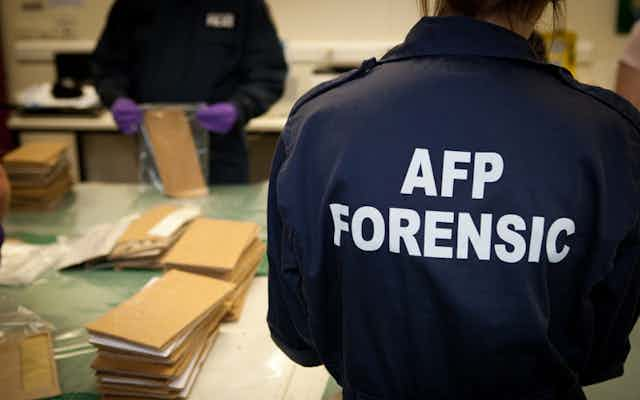Small quantities of synthetic opioids such as fentanyl are being smuggled past customs barriers and used to create recreational drugs, which are spreading at an alarming rate with the help of cryptocurrencies.
Fentanyl, for example, has a massive multiplier effect – a mere 10 grams could produce as much as three kilograms of 33% pure synthetic heroin valued at about US$150,000 in the Australian illicit market.
United Nations illicit drug user surveys and seizures suggest recreational drug use is on the rise. This is especially so with synthetic opioids and new psychoactive substances such as fentanyl derivatives and synthetic cannabinoids (for example, Kronic).
Fentanyl and its derivatives not only pose a risk to recreational drug users, but are also increasingly controlled by organised crime.
A fatal dose of fentanyl can be as little as two milligrams; the equivalent of four grains of salt. Other versions of fentanyl are even more potent. For example, carfentanyl is 10,000 times more potent than morphine – a fatal dose is invisible to the naked eye.
Misuse of drugs, including opioids, is a serious public health issue in Australia, with 1,808 drug-induced deaths recorded in 2016, the highest number in 20 years. Such a high rate of drug-induced fatalities has not been recorded since the 1990s heroin epidemic.
How the spread of synthetic opioids is changing
Offshore dark net vendors shipping drugs to Australia generally offer 20-50% cheaper prices than those offered by their domestic counterparts.
Precursor chemicals for methamphetamine and new psychoactive substances are being produced on an industrial scale in China and India, and shipped into North America via Mexico. Significant quantities are diverted to the small but lucrative Australian illicit market.
Dark net vendors use stealth packaging and rely on huge postal volumes to camouflage deliveries and overwhelm detection methods.
Chinese and South American crime groups dominate the transcontinental supply of these illicit products, and have adapted to the opportunities of the online market place offered by dark net markets.
In October 2015, China started to control export on previously under-regulated pharmaceutical and new psychoactive substances production. In 2017, the highly potent version of fentanyl, carfentanyl, was prohibited. Industrial production of this drug then moved to under-regulated states.
Recent seizures show the attraction of this illicit market. In August 2017, New York police seized 88.4 kilograms of fentanyl and fentanyl-laced heroin. This seizure included 63 kilos of pure fentanyl, which would have yielded 32 million potentially lethal doses of the drug.
There’s also been a number of recent seizures of fentanyl and carfentanyl arising from dark net purchases in Australia.
The role of the dark net markets
The Australian National Drug and Alcohol Research Centre began monitoring dark net market drug trends in July 2016, noting the most common drugs on offer were cannabis, pharmaceuticals, MDMA, cocaine and methamphetamine. In 2016, two opioid versions appeared in the top ten new psychoactive substances on sale for the first time.
Australia’s isolated and lucrative drug market has encouraged users to turn to online sources to access drugs. Dark net markets created by the union of Tor (The Onion Router) and the convenience of anonymous e-currencies provide eBay-style sites that enable users to purchase products anonymously.
The Australian National University Cybercrime Observatory identified Dream Market as the largest English language dark net market in the world. It’s also resilient, withstanding distributive denial of service attacks by competitors or extortionists, while avoiding seller scams that have plagued other markets.
In October 2017, 100,722 products involving 1,900 vendors were listed on Dream Market. Drugs account for half of all products. Within this, the most sold is cannabis, followed by amphetamine, opioids, psychedelics, benzodiazepines and steroids.
Of the 4,500 opioid products for sale, fentanyl comprises 10% of the drug make-up. Compared to a May 2015 data-capture substantially more opioids are now listed (a 24-fold increase).
Fighting the spread
In targeting domestic vendors, police are trying to gain a better understanding of the business models employed by drug vendors and the nature of the criminal networks involved.
Synthetic opioids and other new psychoactive substances are redefining the traditional high-value – low volume or low value – drug market. These drugs change the distribution method, enabling highly potent, low quantity drugs to be posted or shipped across frontiers with a frequency that recalls the Chinese idiom “ants moving houses”.
Underground digital markets are volatile and constantly shifting, with an operational lifespan of around 18 months. Larger markets attract unwanted attention from law enforcement and competitors.
Peer-to-peer marketplaces such as Open Bazaar 2.0 offer an alternative to avoiding disruption by law enforcement and competitors. A peer-to-peer approach does not rely on a single traditional host server, but on distributive hosting that reduces the impact of arrests, exit scams or extortion.
Australia can’t escape the uptake of these new psychoactive substances and synthetic opioids, but might still have time to avoid a US-scale epidemic. Novel ways to disrupt dark net sources, operations, and the immunity of crime networks will be critical to solving this problem.
Julian Slater, Assistant Commissioner with the Australian Federal Police has contributed his expertise to this article.
This article has been corrected since publication to use the correct term – new psychoactive substances.

